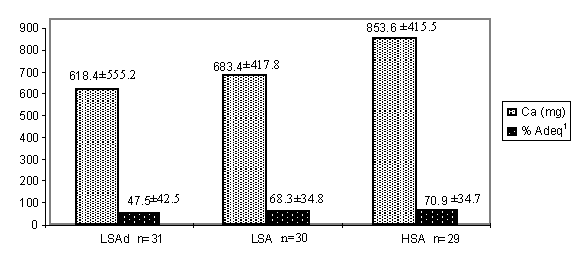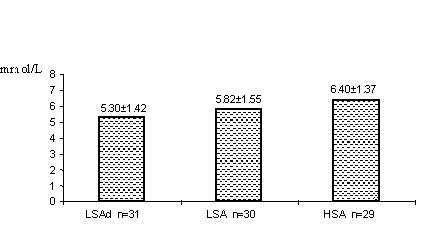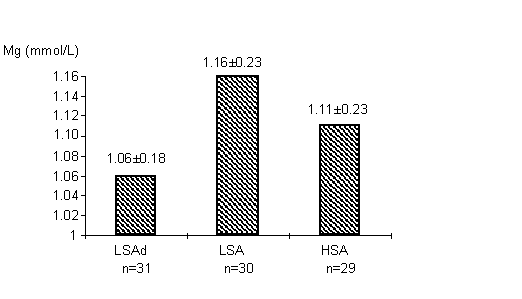Servicios Personalizados
Revista
Articulo
Indicadores
-
 Citado por SciELO
Citado por SciELO -
 Accesos
Accesos
Links relacionados
-
 Similares en
SciELO
Similares en
SciELO
Compartir
Archivos Latinoamericanos de Nutrición
versión impresa ISSN 0004-0622versión On-line ISSN 2309-5806
ALAN v.54 n.1 Caracas mar. 2004
Calcium and magnesium concentrations in mature human milk: influence of calcium intake, age and socioeconomic level
Vítolo, M.R., Valente Soares, L.M., Carvalho, E.B., Cardoso, C.B.
Federal University of São Paulo, SP, Brazil - State University of Campinas, SP, Brazil.
SUMMARY. Concentrations of calcium and magnesium were measured in mature milk, collected between 30 and 90 days after childbirth, from a group of 90 mothers between 14 and 39 years of age, exclusively breastfeeding. The group was divided into three sub-groups: low socioeconomic-level adolescents (LSAd), low socioeconomic-level adults (LSA), and high socioeconomic-level adults (HSA). Each mothers nutritional status was determined using the body-mass index (BMI) and her eating habits, obtained on the basis of a 24-h dietary recall. Adolescent and adult mothers in the low socioeconomic-level group had lower average calcium intake (LSAd = 618.4 ± 555.2 mg and LSA = 679.4 ± 411.4 mg) than adult mothers in the higher socioeconomic-level group (853.6 ± 415.5 mg). The average concentration of calcium in the adolescent mothers milk (LSAd) was significantly lower (5.30 ± 1.42 mmol Ca/L, P= 0.01) than that of the two adult groups (LSA = 5.82 ± 1.55 mmol Ca/L and HSA = 6.40 mmol Ca/L). The average magnesium concentrations for all groups did not show significant differences (LSAd = 1.06 ± 0.18, LSA = 1.16 ± 0.23 and HSA = 1.11 ± 0.23 mmol Mg/L, for P= 0.16). These results indicate that magnesium concentrations in mature human milk do not seem to depend on maternal nutritional status. The condition of adolescence, however, associated with lower calcium intake by the mother, resulted in lower calcium concentrations in the milk secreted when compared to that of adult mothers.
Key words: Calcium, magnesium, human milk.
Concentrações de cálcio e magnésio em leite humano maduro. Influencia da ingestão de cálcio, idade e nível sócioeconômico da nutriz.
RESUMO: Concentrações de cálcio e magnésio foram medidas em leite maduro colhido entre 30 e 90 dias após o parto de 90 mães em regime exclusivo de aleitamento ao peito e com idades entre 14 e 39 anos. O grupo de doadoras foi dividido em três sub-grupos: adolescentes de baixo nível socioeconômico (LSAd), adultas de baixo nível socioeconômico (LSA), e adultas de alto nível socioeconômico (HSA). O estado nutricional de cada doadora foi determinado usando o índice de massa corporal (BMI) e seus hábitos alimentares com base em um inquérito recordatório das últimas 24 horas. Mães adolescentes e adultas dos grupos de baixo nível socioeconômico apresentaram uma ingestão média de cálcio (LSAd = 618.4 ± 555.2 mg e LSA = 679.4 ± 411.4 mg) do que as mães do grupo alto nível (853.6 ± 415.5 mg). A concentração media de cálcio no leite das mães adolescentes (LSAd) foi significativamente mais baixo (5.30 ± 1.42 mmol Ca/L, P= 0.01) que as mães adultas dos dois outros grupos (LSA = 5.82 ± 1.55 mmol Ca/L e HSA = 6.40 mmol Ca/L). A concentração media de magnésio para todos os grupos não mostrou diferença significativa (LSAd = 1.06 ± 0.18, LSA = 1.16 ± 0.23 e HSA = 1.11 ± 0.23 mmol Mg/L, for P= 0.16). Estes resultados indicam que a concentração de magnésio em leite humano maduro não parece depender do estado nutricional materno. No entanto, a condição de adolescência associada a uma ingestão mais baixa de cálcio pela mãe resultou em concentrações mais baixas de cálcio no leite secretado quando comparado ao leite de mães adultas.
Palavras-chave: Cálcio, magnésio, leite humano.
Recibido: 19-07-2002 Aceptado: 14-08-2003
INTRODUCTION
Human breast-milk composition is dependent on factors inherent to the lactating process itself and other maternal and gestational factors such as maternal age, nutritional status, diet, parity and gestational age (1). Concentrations of vitamins and minerals in human milk have been found to vary widely around the globe. An extensive review of the subject concluded that there is still controversy about which factors have a bearing on calcium concentrations in human milk (2). It also pointed out that maternal diet, parity and socioeconomic condition have not been correlated with calcium concentrations in human milk. From the data collected by these authors, calcium and magnesium concentration ranges of 4,99 – 7,48 mmol/L and 1.23-1.64 mmol/L and, respectively, are to be expected for well-nourished women and are supposedly not affected by intake of the mineral in the diet or in supplements.
Studies conducted in Brazil did not find differences in calcium and magnesium concentrations in colostrum from well-nourished and undernourished mothers from diverse socioeconomic conditions (3,4). On the other hand, colostrum from adolescent mothers under 17 years of age showed higher calcium and magnesium concentrations than colostrum from mothers aged between 17 and 20 years (5). The first-known report in the literature on calcium concentrations in adolescent mothers mature milk reported higher concentrations of calcium for this group than other age groups (6).
The mechanisms that control nutrient synthesis in the mammary gland are subject to maternal, gestational and environmental factors (1). Owing to the number and complexity of the factors involved, special care is necessary to isolate the key factors that determine the composition of human milk. The objective of the present study was to evaluate how the state of adolescence, intake of calcium by the lactating mother and socioeconomic situation affected the concentrations of calcium and magnesium in mature milk when the parity and nutritional-state variables were controlled.
MATERIALS AND METHODS
Milk donors
The study group consisted of ninety primiparous mothers, between 14 and 39 years of age, and lactating for between 30 and 90 days, with infants being exclusively breastfed. The criteria for inclusion were that the subjects be healthy, non-smoking, using no medications or vitamin supplements during pregnancy or after, with single-conception pregnancy, childbirth and post-partum occurring normally; , and who showed an acceptable body-mass index (> 19 kg/ m2). The donors were classified in three groups: low socioeconomic-level adolescent (LSAd, < 19 years old), low socioeconomic-level adult (LSA), and high socioeconomic-level adult (HSA). The LSAd and LSA groups were recruited among patients of public institutions oriented toward caring for the underprivileged and the HSA group among patients of private clinics. Among the low socioeconomic-level mothers, 74.2% of LSAd and 41.9% of LSA had not finished primary school and none had a university degree; 35.5% of LSAd and 51.6% of LSA were married. Among the high socioeconomic-level (HSA) group, 50% had university degrees, 90% were married and 80% pursued careers outside their homes. All donors agreed to take part in the study.
Sample collection
Samples of mature milk were collected by manual expression of both breasts for several days, and at different times during the afternoon, to account for variations that might occur at regular times of the day, until a pool of 150 mL was reached for each subject. The milk was collected directly into propylene flasks with screw tops, previously washed by immersion in neutral detergent (Extran, Merck) for 24 hours. The snap caps were then rinsed with deionized water and soaked in nitric acid solution (1:1) for another 24 hours. Again they were washed with deionized water and dried in an oven at 40oC. The samples were stored at – 20oC until analysis.
Calcium and magnesium determinations
The samples (1 mL) were mixed with 10 mL of concentrated nitric acid, heated by infrared radiation until the digestion was completed, and the acid was allowed to dry. The residues were dissolved in concentrated nitric acid and enough lanthanum solution was added give a final concentration of 1.0% of nitric acid and 0.5% of lanthanum when the solutions were taken to volume in volumetric flasks. The concentration of calcium and magnesium was measured using a Perkin Elmer, model 5100 PC,flame atomic-absorption spectrophotometer, fitted with a deuterium background corrector. Duplicate determinations were made. For analytical control, NIST 1549 non-fat milk powder reference material was analyzed under the same conditions (Table 1). Each group of analyses included an in-house reference material (whole cow milk), previously analyzed 15 times on different days. The results indicated the adequacy of the procedure used.
Results of the certified sample analysis (Non-fat milk powder, NIST 1549) by atomic absorption spectrometry:
| Material | Origin | No. Analyses | Certified value (%) | Value found (%) | ||
| Ca Mg | Ca Mg | |||||
| Non-fat milk powder | NIST 1549 | 3 | 1.30±0.05 | 0.12±0.03 | 1.34±0.20 | 0.114±0.002 |
TABLE 2
Calcium intakes and calcium concentration in milk of adolescent and adult mothers of different social and economic levels.
| Calcium intake (mg) | <400 | 400 – 800 | >800 |
| Number of subjects | 26 | 31 | 33 |
| Average calcium | 5.80 ± 1.48 | 5.85 ± 1.66 | 5.83 ± 1.40 |
p=0.99 ns
Dietary recall
The dietary intake was calculated on the basis of a 24-h recall by each subject, using the Program for Nutrition Support, Version 2.5, from the Health Data Center, Federal University of São Paulo, Brazil. The dietary calcium and magnesium intake for each subject was compared with the dietary reference intakes of the American Food and Nutrition Board (7).
Statistical analysis
The Kruskal Wallis test was applied to compare the calcium concentrations found in milk samples from each group (LSAd, LSA, HSA) with respect to the age, socioeconomic level and daily calcium intake variables (< 400 mg, 400 – 800 mg, and >800 mg). Within each group the test was conducted to check for correlations between the calcium intake by the mothers and the calcium concentration in the milk. The null hypothesis level was set at 0.05 (7).
RESULTS
The analysis of the diet showed that the calcium intake was lower (p=0,02) for both groups of low socioeconomic-level mothers, adolescents (618,4± 555,2) and adults (683,34± 417,8) when compared with high socioeconomic-level mothers (853,6± 415,2) (Figure 1).
Average calcium intake (mg) and adequacy (%) of calcium intake recommended to lactating mothers according to age and socioeconomic level.

(p = 0.02 , LSAd; LSA < HSA)
The concentration of calcium in the milk of the adolescent group (LSAd) was 5.30 ± 1.42 mmol/L and significantly lower (p = 0.01) than the concentrations in the adult groups (LSA = 5.82 ± 1.55 mmol/l and HSA = 6.40 ± 1.37 mmol/L) (Figure 2). For magnesium levels, however, there was no significant difference between the donor groups (LSAd = 1.06 ± 0.18 mmol/L, LSA = 1.16 ± 0.23 mmol/L, and HSA = 1.11 ± 0.23 mmol/L, at p = 0.16) (Figure 3). No correlation was found between the calcium intake by the mothers and the calcium concentration in milk for all groups ( LSAd- p=0.86/r2=0,00; LSA- p=0.51/r2=0.015; HAS-p=0.97/r2=0.00 ).
Average concentrations of calcium in mature milk according to the mothers age and socioeconomic level (LSAd = Low socioeconomic level adolescents, LSA = low socioeconomic level adults, HSA = high socioeconomic level adults).

p=0.01 (LSAd < LSA;HSA)
Average concentrations of magnesium (mmol/L) in mature milk according to mothers age and socioeconomic level (LSAd = Low socioeconomic level adolescents, LSA = low socioeconomic level adults, HSA = high socioeconomic level adults).

p=0.16 ns
DISCUSSION
The present study found smaller calcium concentrations in milk secreted by adolescent mothers when compared to the two groups of adults. The calcium intake by adolescent mothers was below the reference intake and was the lowest when compared to the two adult groups. But still no correlation was observed between calcium intake by the adolescent mothers and the calcium concentration in milk. Studies conducted in Gambia showed no connection between low calcium intakes by mothers during the lactating period and calcium concentrations in their milk. On the other hand, the intake of calcium during pregnancy seemed to have a direct bearing on calcium in milk concentrations (8,9). Calcium levels in human milk have been found to vary from 6.32 to 10.75 mmol/L (10,11).
Lower calcium intake by Nepalese lactating mothers did adversely affect the concentrations of calcium in the milk secreted. A greater capability for mobilization of stored calcium was pointed out as the probable cause, since higher levels of hydroxiproline were found in the mothers urine (12). A lower calcium intake during the three last months of pregnancy was correlated with higher alkaline phosphatase levels in serum during lactation in Spanish women (13). On the other hand, no correlation was found between calcium concentrations in milk and mobilization of bone calcium by secretion of hormones involved in calcium metabolism (1,25 dihydroxycholecalciferol, parathyroid hormone, and carrier proteins) (14,15). Specific parathyroid hormone protein fractions did correlate with calcium concentrations in human milk (16). A previous study had shown that higher levels of calcitrophic hormones were present in lactating adolescents. The results suggest that their incomplete growth may limit the calcium turnover in lactation metabolism (17). A recent proposal for reference intake of calcium during breastfeeding has taken into consideration the nursing adolescent (1300 mg/day as advised reference intake) as a risk group for calcium metabolism but not nursing adults (1000 mg/day as advised reference intake) (7). It should be noticed that the reference intake of calcium for nursing adult women is not different from that of non-nursing adult women. The nutrient requirement is known to be higher in all women that are breastfeeding. However, the reference intake for calcium has not been modified due to the higher availability that occurs in the organism of nursing women in this period, at least in the case of adult mothers.
The present study has confirmed other reports that magnesium concentrations in human milk do not depend on maternal conditions and appear constant when different groups are compared. For calcium, the results indicate that the state of adolescence, associated with lower calcium intakes, causes lower calcium concentrations in milk, although the average concentrations found are adequate to supply the infants needs. In conclusion, adolescent mothers may be considered a risk group in terms of calcium concentrations in mature milk and should be advised to consume foods considered good sources of calcium during pregnancy and lactation. Further studies involving bone metabolism are necessary to clarify the results of the present study.
ACKNOWLEDGEMENTS
E.B. Carvalho and C.B. Cardoso gratefully acknowledge the undergraduate research scholarships received from the Fundação de Amparo à Pesquisa do Estado de São Paulo (FAPESP).
REFERENCES
1. LAWRENCE, R.A. – Breastfeeding. A guide for the medical profession. St. Louis, Mosby,1985. 601 p. [ Links ]
2. BATES, C.J.; PRENTICE, A; Breast milk as a source of vitamins, essential minerals and trace elements. Pharmac Ther. Vol. 62, pp. 193-220, 1994. [ Links ]
3. ESCRIVÃO, M.MAS.; QUEIROZ, S.S.; NÓBREGA, F.J.; VÍTOLO, M.R.; FISBERG, M.; LOPEZ, F.A.: Concentrations of iron, zinc, cooper, calcium, phophorus and magnesium in the colostrum of adult mothers from two socioeconomic levels in Nóbrega F.J.. Human Milk Composition, Revinter, 1996. [ Links ]
4. VITOLO, M.R.V.; NÓBREGA, F.J.; ANCONA LOPEZ, F. Colostrum composition (Total Fat, Total Energy, Immunoglobulin, Zinc, Calcium and Fatty Acids) of High and Low Socioeconomic Level, Eutrophic and Malnourished Adult Nursing Mothers. In: Nobrega, FJ. Human Milk Composition. Revinter, São Paulo, 1996. p. 120- 134. [ Links ]
5. GOUVÊA, L.C.; QUEIROZ S.S.; NÓBREGA, F.J.; NOVO, N.F.: Calcium, magnesius and phosphorus content of colostrum from high and low socioeconomic level adolescent mothers in Nóbrega F.J.. Human Milk Composition, Revinter, 1996. [ Links ]
6. LIPSMAN, S.; DEWEY, K.G.; LÖNNERDAL, B. - Breast-feeding among teenage others: milk composition, infant growth and maternal dietary intake. J. Pediatr. Gastroenterol Nutr., 4:426-34,1985. [ Links ]
7. INSTITUTE OF MEDICINE (IOM), Food and Nutrition Board. Dietary Reference Intakes for calcium, phosphorus, magnesium, vitamin D and fluoride. Washington, DC:National Academy Press, 1997. [ Links ]
8. PRENTICE, A; JARJOU, L.M.A; COLE, T.J.; STIRLING, D.M.; DIBBA, B.: Calcium requirements of lactating Gambia mothers: effects of calcium supplement on breast-milk calcium concentration, maternal bone mineral content, and urinary calcium excretion. Am. J Clin. Nutr.; 62:58-67,1995. [ Links ]
9. PRENTICE, A; DIBBA, B.; JARJOU, L.M.A; LASKEY, M.A; PAUL, A A: Is breast milk calcium concentration influenced by calcium intake during pregnancy?. The Lancet. Vol 344,1994 [ Links ]
10. PRENTICE, A; BARCLAY, D. V.: Breast-milk calcium and phosphorus concentrations of mothers in rural Zaire. European Journal of Clinical Nutrition (l991) 45,611-617, 1991. [ Links ]
11. CARIAS, D.; VELÁSQUEZ G.; CIOCCIA, A. M.; PIÑERO, D.; INCIARTE, H.; HEVIA, P.: Variaciones temporales en la composición y aporte de macronutrientes y minerales en leches maternas de mujeres venezolanas. Archivos Latinoamericanos de Nutrition. Vol. 47 n° 2, 1997. [ Links ]
12. MOSER, P; REYNOLDS, R.D; ACHARYA, S.; HOWARD, PAT., ANDOM, M.B.; Calcium and Magnesium dietary intakes and plasma and milk concentrations of Nepalese lactating women. Am. J. Clin. Nutr. 47:735-9,1988. [ Links ]
13. ORTEGA, R.M.; MARTINEZ, R.M.; QUINTAS, M.E; LÓPEZ SOBALER, A.M.; ANDRÉS.P. Calcium levels in maternal milk: relations with calcium intake during the third trimester of pregnancy. Br.J.Nutr. 79 (6): 501-7,1998. [ Links ]
14. RITCHIE, L.D.; FUNG, B.P.H.; TURNLUND,J.R.; LOAN, M.D.V.;CANN,C.E.; KING J.C. A longitudinal study of calcium homeostasis during human pregnancy and lactation and after resumption of menses. Am.J.Clin.Nutr.67: 693-701,1998. [ Links ]
15. SEKI, K. ; KATO, T.;SEKIYA, S.;MAKIMURA, N.;KUDOH, K.;FURUYA, K.;NAGATA, I. Parathyroid-hormone related protein in human milk and its relation to milk calcium. Ginecol.Obstet.Invest. 44(2):102-6, 1997. [ Links ]
16. UEMURA,H.; YASUI,T.; YONEDA,N.; IRAHARA, M.; AONO,T. Measurement of N- and C-terminal-region fragments of parathyroid hormone-related peptide in milk from lactating women and investigation of the relationship of their concentrations to calcium in milk. J.ENDOCRINOL.153:445-51,1997 [ Links ]
17. CHAN,G.M; McMURRY,M.; WESTOVER,K.; ENGELBERT-FENTON, K.; THOMAS,R. Effects of increased dietary calcium intake upon the calcium and bone mineral status of lactating adolescent and adult women. Am J.Clin.Nutr. 46:319-23,1987. [ Links ]














